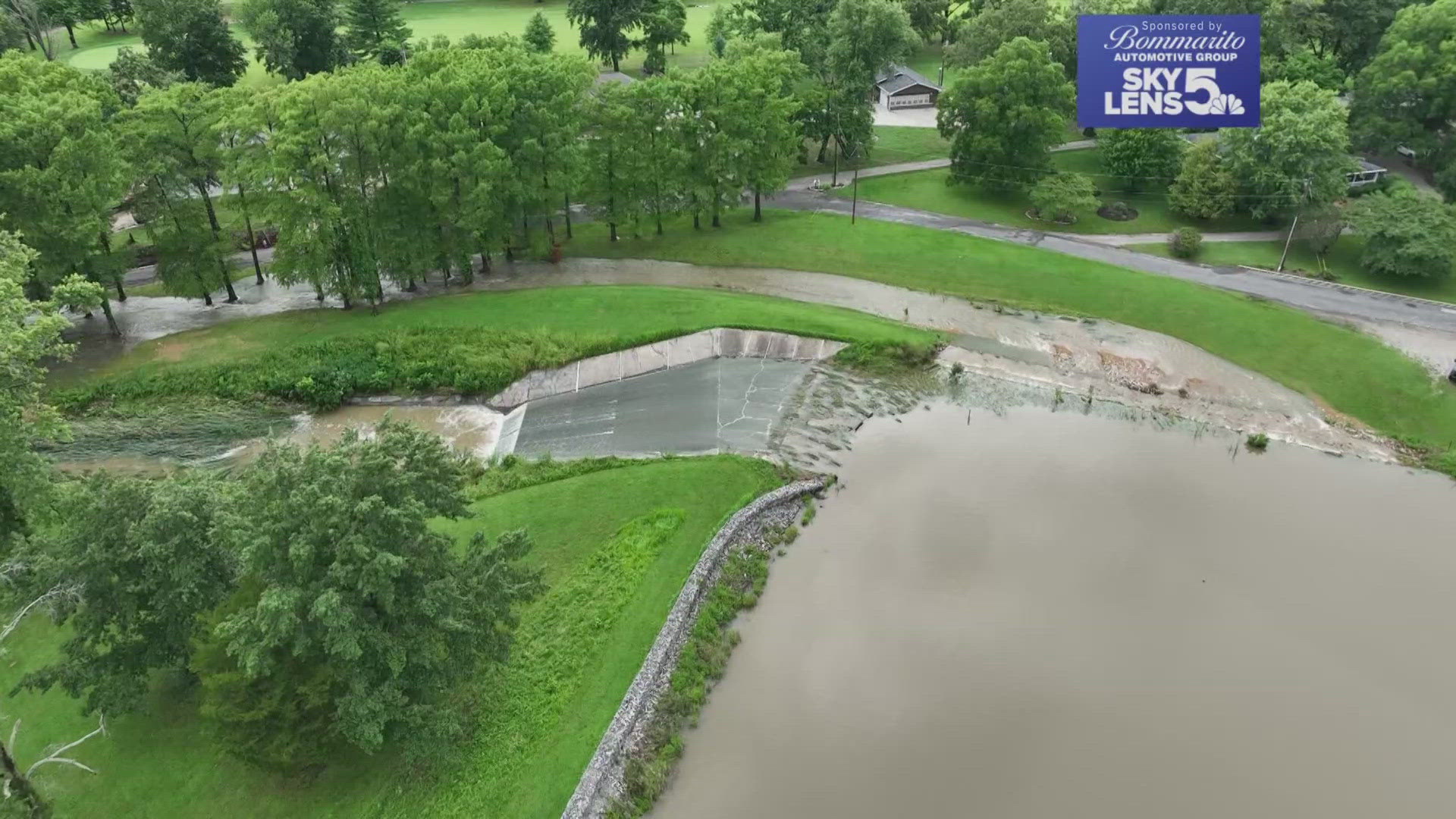NASHVILLE, Ill. — Numerous 911 calls shared the terror residents of Nashville, Illinois, faced in the moments after floodwaters overtopped the community's dam.
“It was a shock," Nashville resident Justine Harre told 5 On Your Side. "Thankfully, we live up on a hill and we were just south of it, so we were OK."
Harre lives two houses away from the evacuation zone announced after water crested over the Nashville City Reservoir Dam. Alone with her two young children, she saw the water inching closer from outside her window.
In the span of hours, the city was hit with at least 6 inches of rain. It caused water to flood the city’s nearly 90-year-old dam. Hundreds of homes were evacuated, according to Loren Wobig, director at the Illinois Department of Natural Resources Office of Water Resources.
Jayette Bolinski, a spokesperson with the Illinois Department of Natural Resources, said the Nashville City Reservoir Dam functioned the way it was supposed to function following heavy rain. An emergency feature called a fuse plug likely minimized the flooding impact from the dam, experts said. It’s made of sand, allowing it to erode if water gets too high.
Without that safeguard, industry sources said the dam could have failed completely. The feature helps dams to safely release water and prevent a failure. The flooding could have been far worse without the fuse plug spillway, according to the National Performance of Dams Program, a research organization headquartered at Stanford University.
Nashville's 'high-hazard' dam
State regulators have long classified the Nashville City Reservoir Dam as "high hazard," a rating that reflects the potentially deadly risks associated with its failure. Data shows about 15% of dams in Illinois have the same rating. In Missouri, it’s 28%, according to the Association of State Dam Safety Officials, a nonprofit advocacy organization dedicated to improving the condition and safety of dams and lowering the risk of dam failures, citing National Inventory of Dams data.
Despite the fear of the recent flooding in Nashville, people who live in the area are counting their blessings.
Thankfully there were no injuries following the incident at Nashville’s dam. Industry sources said the flooding reflects the severe threat posed by Mother Nature and the struggle of our aging infrastructure to keep up.
Does Nashville's dam need repairs after Tuesday's flood?
The Washington County Emergency Management Agency told 5 On Your Side that two staff members from the Army Corps of Engineers in St. Louis, along with City of Nashville employees, have inspected the Nashville Reservoir. The dam's integrity is intact and the area has been deemed safe for residents.
“Flood waters are receding naturally in most areas, as expected after a flash flood event," according to a news release from officials. "The speed of receding waters varies based on several factors. Residents should avoid standing water due to hidden dangers such as toxins, chemicals, and sharp objects. The road could also have collapsed under the water. No boil order has been issued in the county as of this time."
Local damage assessments are ongoing. So far, over 20 reports of damage have been received, including flooded basements and water damage to businesses and at least one church.
The EMA told us that until the need for supplies and volunteers is better assessed, the agency is not directly collecting donations or requesting volunteers. Those wishing to donate items or their time should reach out to their local office of a charity of their choice (Red Cross, The Salvation Army, The United Way). Local nonprofits or churches within Washington County, Illinois may also be accepting donations. We will share this information as it becomes available.
Flooding event signals need for infrastructure investment
Congress approved a record of roughly $3 billion to modernize dams in 2021, according to the Association of State Dam Safety Officials.
Critics said the amount is not nearly enough. The Association of State Dam Safety Officials estimates that it would cost more than $34 billion to rehabilitate the nation’s non-federally-owned “high-hazard dams," like Nashville's, to modern standards in anticipation of extreme weather.
“It is difficult for these often-aging dams to handle the more frequent and intense storms resulting from the changing climate," said Lori Spragens with the Association of State Dam Safety Officials. "It is urgent that our nation's dams are prepared for these storms to protect those downstream. Dams, especially those near people living and working, must be well maintained, rehabilitated if necessary, and have an emergency action plan."
Spragens also urged federal officials to address the growing backlog of dams needing rehabilitation. Benjamin Dierker with the think tank the Alliance for Innovation and Infrastructure agreed, saying infrastructure is often overlooked.
"Restoring an infrastructure element to its prior state before an incident may simply result in another failure when similar conditions are present in the future," said Dierker, with the nation's only public policy think tank dedicated to infrastructure. "Resilience ensures rebuilding and maintenance efforts are more proactive and account for future but realistic probabilities.”
The I-Team discovered safety upgrades will be increasingly critical. Experts predict more flooding in the coming years linked to climate change, straining old infrastructure.
“Unfortunately, this type of an event is not uncommon... and therefore it's fairly common that they're found deficient," said Martin McCann, director of the National Performance of Dams Program at Stanford University. He also called aging infrastructure a growing national problem as severe weather becomes more frequent.
Want to contact Paula? Leave a voice message at 314-444-5231 or email her at pvasan@ksdk.com.

